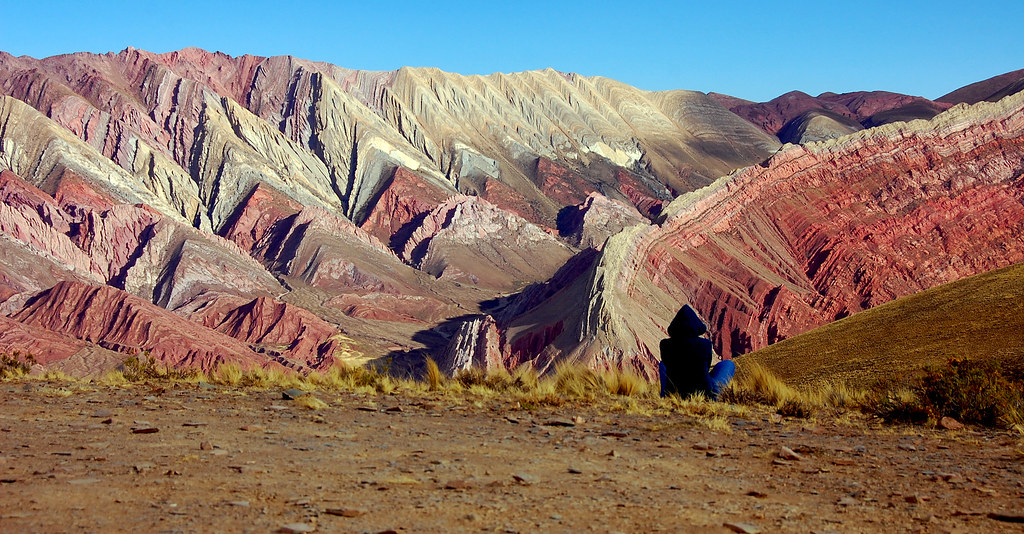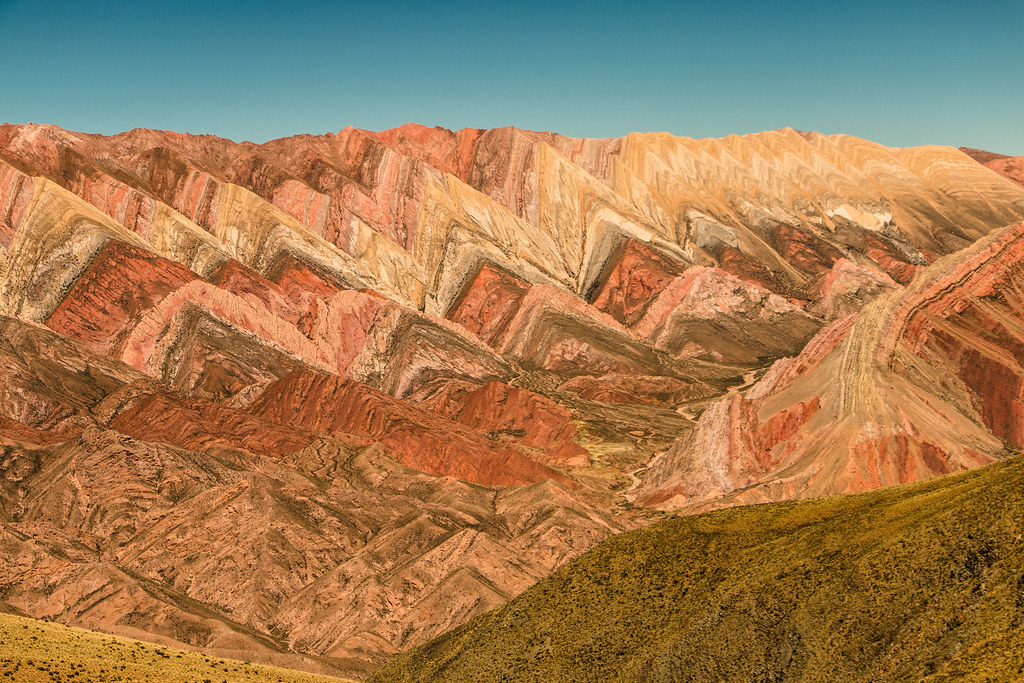Soil is typically brown, but when mixed with the right minerals in right quantities, it can yield a fascinating range of colors. You can see such coloring in the walls of the Great Canyon in Arizona and the desert in Utah, but in some places the colors are such extreme and varied that it’s almost surreal.
Danxia landform
One of the best examples of colorful landform is on Mount Danxia, in Guangdong Province, in China. The Danxia landforms are made of strips of red sandstone alternating with chalk and other sediments that were deposited over millions of years, like slices of a layered cake. Over 700 individual locations have been identified in China, mostly in southeast and southwest China, where this type of colors and layers can be seen—all of these are referred to as Danxia landforms.
Photo credit: Evgeni Zotov/Flickr

Photo credit: yeung ming/Flickr
Photo credit: yeung ming/Flickr

Photo credit: yeung ming/Flickr
The Mountains of Hornocal
Located just 25 km from Humahuaca, in north-west Argentina, along a well-graded unpaved road, are the mountain of Hornocal or “Serranias del Hornocal”. The incredible colors and the inverted-V shaped formation seen here is part of the limestone formation called Yacoraite that extends from Peru to Salta, through Bolivia and the Quebrada de Humahuaca. The road that leads to this place, located at an altitude in excess of 4,300 meters, is inaccessible by bus, but can be easily reached by a regular car or a 4x4.


The Hill of Seven Colors, Purmamarca
About 70 km south of Humahuaca is another rainbow-colored hill—Cerro de los Siete Colores, or the Hill of Seven Colors, located near the tiny village of Purmamarca, in north-western Argentina. The hill was formed by a complex geological process that involved deposition of sea, lake and river movements and subsequent elevation of the land due to the movement of the tectonic plates about seventy-five million years ago. It is said that you can see seven colors in the hill, but most people can pick out only four. The colors are most clearly visible in the morning.
Photo credit: Leandro Kibisz/Flickr

Photo credit: Los viajes del Cangrejo/Flickr

Photo credit: Mariano Mantel/Flickr
Ausangate Mountain
The Ausangate mountain, about 100 kilometers southeast of Cusco, in Peru, is also known as Rainbow Mountain or Cerro Colorado because of its exposed layers of rock bearing red, ochre, and turquoise colors. The mountain is considered to be holy and believed to be the deity of Cusco by local Peruvians. It is a site of daily worship and offerings by local citizens. Every year thousands of Quechua pilgrims visit the Ausangate Mountain for the Star Snow festival which takes place a week before the Corpus Christi feast.
Photo credit: Sun Gate Tours

Photo credit: Sun Gate Tours
Painted Hills of Oregon
The colorful layers and banded striations that make up the Painted Hills in Wheeler County, Oregon, the United States of America, were formed over 35 million years ago by volcanic ash layers deposited by ancient eruptions when the area was a river plain. Over time, the layers of ash containing different minerals compacted and solidified into the various bands of colors seen today. The black soil is lignite that was vegetative matter that grew along the floodplain. The grey coloring is mudstone, siltstone, and shale. The red and orange hues are from laterite soil that formed by floodplain deposits when the area was warm and humid.
Photo credit: Richard White/Flickr

Photo credit: BLM Oregon/Flickr

Photo credit: Bruce Fingerhood/Flickr
Seven Colored Earths, Mauritius
The Seven Colored Earths, a small region near the village of Chamarel, Mauritius, is a relatively small area of about 7,500 square meters comprising of sand dunes of seven distinct colors (approximately red, brown, violet, green, blue, purple and yellow).The sands were formed from the decomposition of volcanic rock (basalt) gullies into clay, further transformed into ferralitic soil by total hydrolysis (chemical break- down of minerals by water). The two main elements of the resulting soil, iron and aluminum, are responsible for red/anthracite and blue/purplish colors respectively. The different shades of color are believed to be a consequence of the molten volcanic rock cooling down at different external temperatures.

Photo credit: Claire André/Flickr
The Red Earth Terraces of Dongchuan
Some 250 kilometers northeast of Kunming, the capital of China's Yunnan Province, lies Dongchuan, a rural area with the world's most imposing red earth. Spread over vast terraced fields, Dongchuan’s unusual brownish-red color comes from its rich deposit of iron and copper. Exposed to the warm and humid climate of Yunnan, the iron in the soil undergoes oxidization to form iron oxide which is naturally red in color. These oxides, deposited through many years, gradually developed into the extraordinary reddish brown soil seen here today. Every year during spring, when this area is ploughed for agriculture, a large number of visitors and photographers come to see squares of freshly upturned red earth waiting to be sown along with areas of budding green plants. The fiery red soil juxtaposed with emerald green barley, and golden yellow buckwheat, against a blue sky produces one of the richest color palate rarely seen in nature.
Photo credit: JiKang Lee/Flickr

Photo credit: Absolute China Tours

Photo credit: Absolute China Tours
Rainbow Colored Mountains
Rainbow Colored Mountains
4/
5
Oleh
Chandu Numerology







